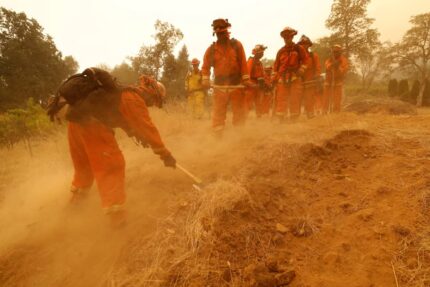Nearly 1,000 incarcerated men and women in California have taken up an extraordinary role in combating the devastating wildfires ravaging southern California. As of now, 939 inmates are actively battling flames through a volunteer program run by the California Department of Corrections and Rehabilitation (CDCR).
These inmate firefighters have been crucial in slowing the spread of fires that have destroyed over 10,000 structures and burned more than 37,000 acres in the Los Angeles area. Embedded alongside the California Department of Forestry and Fire Protection (Cal Fire), the inmates, dressed in prison-orange jumpsuits, work tirelessly cutting fire lines and clearing combustible materials to protect communities. However, the death toll has risen to at least 11, and officials continue to struggle with containment efforts as thousands of emergency responders from various agencies join the fight.
A Program Rooted in Controversy and History
California’s inmate firefighter program, established in 1946, has long been a subject of debate. While some hail it as a rehabilitative initiative offering inmates valuable training and better living conditions than standard prison environments, others criticize it as exploitative. Participants earn between $5.80 and $10.24 per day, with an additional $1 for emergency assignments—wages that pale in comparison to the six-figure salaries earned by professional firefighters.
Critics, like Royal Ramey, a former incarcerated firefighter and co-founder of the Forestry and Fire Recruitment Program (FFRP), argue that the system treats inmates as cheap labor and fails to recognize their sacrifices. Ramey highlighted the lack of posthumous benefits or official acknowledgment for inmates who lose their lives in the line of duty. Despite the low pay, he noted that the program offers inmates a reprieve from overcrowded prisons and the potential to earn time credits that reduce their sentences.
Post-Incarceration Challenges: Stigma and Employment Barriers
Despite the skills and training acquired during their service, many formerly incarcerated firefighters face significant hurdles in finding employment after their release. California’s firefighting industry is often unwilling to hire individuals with criminal records, perpetuating a stigma that prevents these trained workers from fully reintegrating into society.
Ramey’s FFRP seeks to address these challenges by helping formerly incarcerated individuals navigate the job market and break into firefighting roles. His efforts also aim to address the state’s ongoing firefighter shortage, an issue exacerbated by increasingly frequent and severe wildfires. However, changing perceptions and policy remain critical to unlocking opportunities for these individuals.
Wildfires Continue to Devastate Southern California
As California contends with five active wildfires, including the massive Palisades and Eaton fires, the economic and environmental toll is mounting. Over 35,000 acres have already been scorched, and the fires are projected to rank among the most expensive in the state’s history. Resources remain stretched thin, with over 7,500 emergency personnel, including members of the National Guard and firefighters from Canada, deployed to assist.
The role of incarcerated firefighters in this crisis highlights both their indispensable contributions and the contentious nature of their involvement. As the fires rage on, the debate over fair compensation, recognition, and post-incarceration opportunities for these individuals continues to intensify.
Water Shortages and Controversies Surrounding Firefighting Efforts
The firefighting response has been hampered by water shortages, with reports of inadequate supplies from fire hydrants and reservoirs. Governor Gavin Newsom has called for an independent investigation into the issue, which likely impaired efforts to protect homes and evacuation corridors.
In the meantime, political controversies have arisen, including former President Donald Trump’s unsubstantiated claims about water mismanagement. Experts and officials have dismissed these allegations, clarifying that current firefighting challenges are unrelated to water policies aimed at protecting endangered species.
Budget Cuts and Emergency Preparedness in Los Angeles
LA Mayor Karen Bass has faced criticism over a $17.6 million budget cut to the city’s fire department, which some argue has hindered wildfire preparedness. Fire Chief Kristin Crowley warned that the cuts have reduced the department’s capacity to train for and respond to large-scale emergencies.
Mayor Bass defended the decision, asserting that the cuts did not directly impact the ongoing crisis. Experts agree that while LA County possesses some of the world’s most advanced firefighting resources, the intensity of recent wildfires reflects the limits of what can be achieved under extreme conditions.
This unfolding crisis highlights both the critical contributions and the challenges faced by incarcerated firefighters, raising questions about fairness, rehabilitation, and resource allocation in California’s battle against wildfires.














